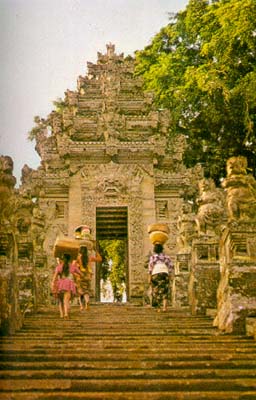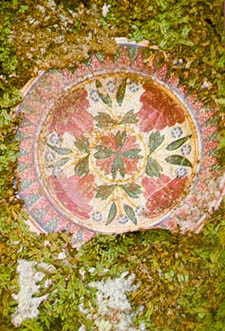
Bangli
|
|
Further
inland the
weather is cooler. Plots abound with sweet potato, peanut, corn and
spices. A high kulkul drum tower marks the entrance to Bangli, capital
of a kingdom descended from the early Gelgel dynasty. The largest and
most sacred temple of the district is Pura Kehen, the terraced mountain
sanctuary and state temple of Bangli.
|

|
|
An ancient
document
tells of the slaughter of a black bull during a feast held at this
temple in the year 1204. Down below at the foot of the stairway, there
is an old temple which contains a collection of historical records
inscribed on bronze plates.
|
|
Statues,
in wayang kulit
shadow play style, line the first terrace from which steps lead to a
magnificent closed gate the people of Bangii call "the great exit".
|
|
Above the
gate looms the
hideous face and splayed hands of KalaMakara, the demonic one who
catches harmful spirits to prevent them from entering. On either side
are statues of villagers gesturing a welcome.
|
|
An
enormous banyan tree
shades the first courtyard, where the walls are inlaid with Chinese
porcelain. An eleven-tiered meru dominates the inner sanctuary. Here,
on the right, you see the three-throned shrine of the Hindu trinity:
Brahma, Siwa, and Vishnu. A hierarchy of deities is carved on the back
of the shrine. By turning left at Bangli, you may bypass the volcano
and take a short cut to Tampaksiring. Just 3 kilometers out of Bangli
on this road is Demulih hill. It is well worth the climb up, for the
view of central Bali is superb, and the hilly setting (worthy of being
declared a sanctuary) is conducive to peace and relaxation.
|

|
|
Bangli
itself, a little
town that is usually passed through, is rewarding and worth a walk
through to view some of the stone Statues and temple reliefs. To reach
the volcanoes of Batur and Abang, continue straight. Many villages in
this mountain region have retained an older form of culture that was
not deeply influenced by the courts of the lower slopes.
|
Copyright
2001-2015, K&D Bali Designs. All rights reserved.
|